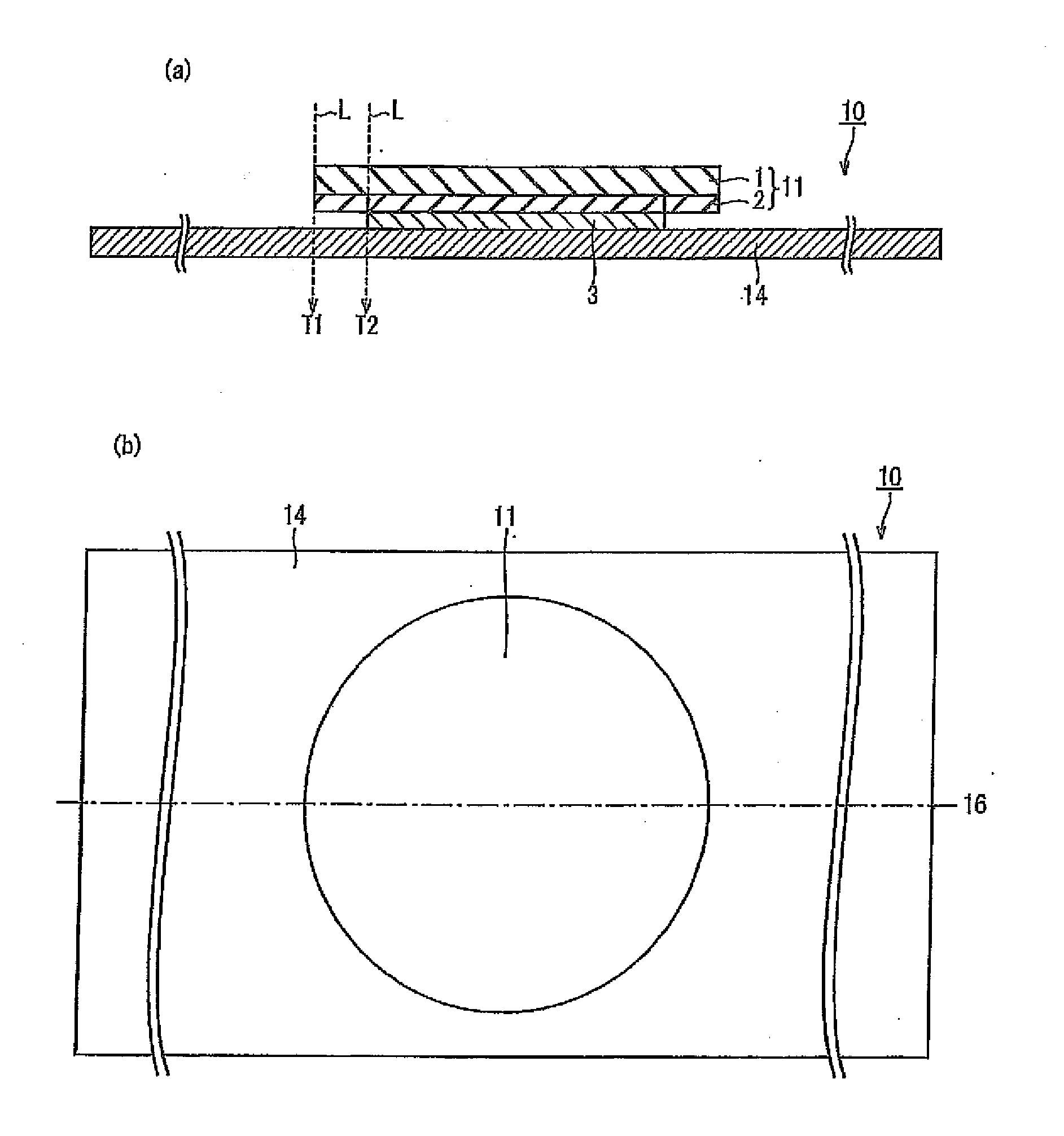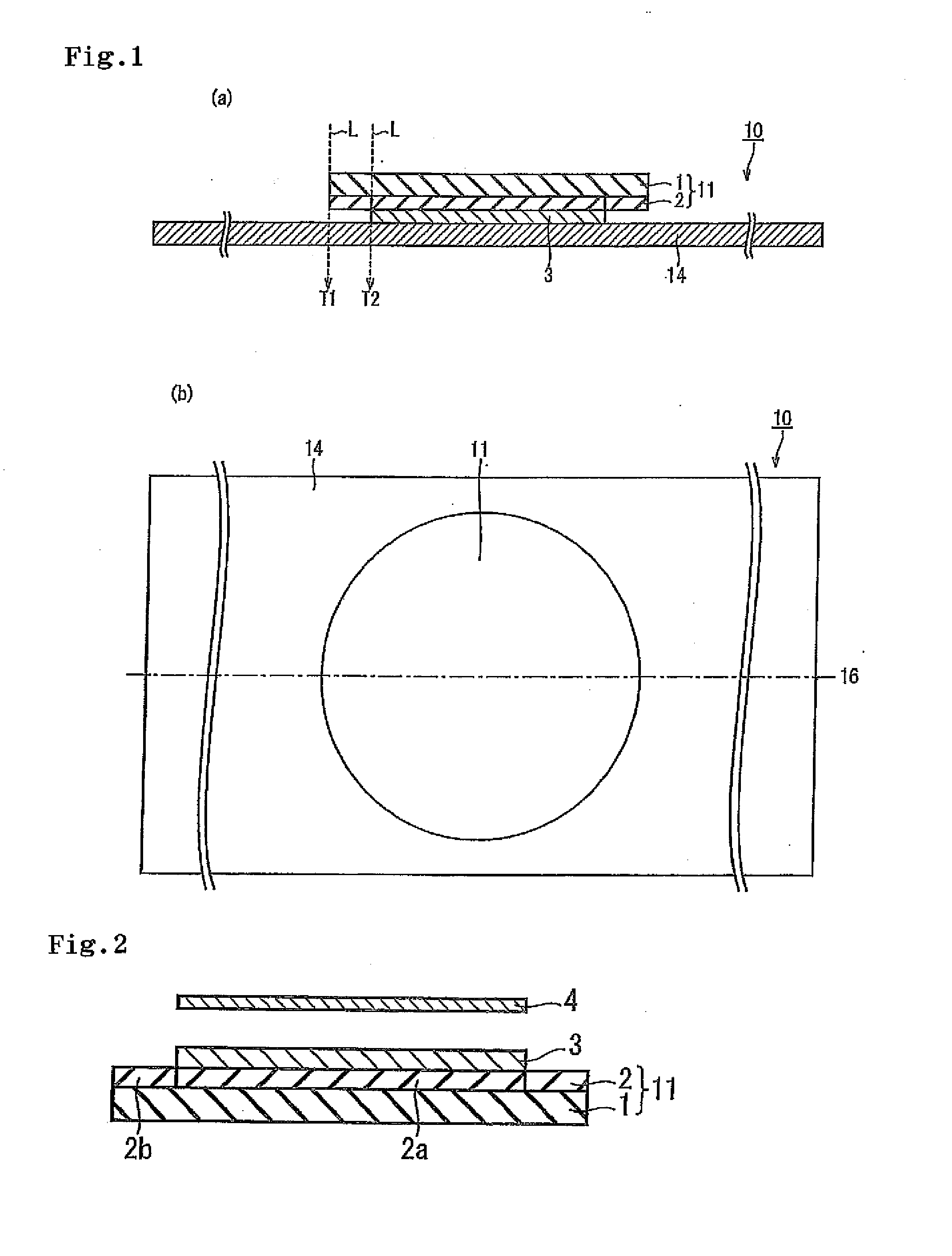Method of manufacturing film for semiconductor device
- Summary
- Abstract
- Description
- Claims
- Application Information
AI Technical Summary
Benefits of technology
Problems solved by technology
Method used
Image
Examples
manufacturing example 1
[0111]In methylethylketone were dissolved 12 parts of an epoxy resin (Epicoat 1004 manufactured by JER), 13 parts of a phenol resin (Milex XLC-4L manufactured by Mitsui Chemicals, Inc.), 100 parts of an acrylic ester polymer having ethylacrylate-methylmethacrylate as a main component (SG-708-6 manufactured by Nagase ChemteX Corporation), and 30 parts of spherical silica (SO-25R manufactured by Admatechs Co., Ltd.) as a filler to obtain an adhesive composition solution having a concentration of 23.6% by weight.
[0112]This adhesive composition solution was applied onto a release-treated film (a release liner) made from polyethylene terephthalate and having a thickness of 50 μm which had been subjected to a silicone releasing treatment, and the resultant was dried at 130° C. for 2 minutes to produced a die bond film A having a thickness of 20 μm.
manufacturing example 2
[0113]In methylethylketone were dissolved 48 parts of an epoxy resin (Epicoat 1004 manufactured by JER), 51 parts of a phenol resin (Milex XLC-4L manufactured by Mitsui Chemicals, Inc.), 100 parts of an acrylic ester polymer having ethylacrylate-methylmethacrylate as a main component (SG-708-6 manufactured by Nagase ChemteX Corporation), and 74 parts of spherical silica (SO-25R manufactured by Admatechs Co., Ltd.) as a filler to obtain an adhesive composition solution having a concentration of 23.6% by weight.
[0114]This adhesive composition solution was applied onto a release-treated film (a release liner) made from polyethylene terephthalate and having a thickness of 50 μm which had been subjected to a silicone releasing treatment, and the resultant was dried at 130° C. for 2 minutes to produced a die bond film B having a thickness of 20 μm.
manufacturing example 3
[0115]In methylethyl ketone were dissolved 193 parts of an epoxy resin (Epicoat 1004 manufactured by JER), 207 parts of a phenol resin (Milex XLC-4L manufactured by Mitsui Chemicals, Inc.), 100 parts of an acrylic ester polymer having ethylacrylate-methylmethacrylate as a main component (SG-708-6 manufactured by Nagase ChemteX Corporation), and 195 parts of spherical silica (SO-25R manufactured by Admatechs Co., Ltd.) as a filler to obtain an adhesive composition solution having a concentration of 23.6% by weight.
[0116]This adhesive composition solution was applied onto a release-treated film (a release liner) made from polyethylene terephthalate and having a thickness of 50 μm which had been subjected to a silicone releasing treatment, and the resultant was dried at 130° C. for 2 minutes to produced a die bond film C having a thickness of 20 μm.
PUM
 Login to View More
Login to View More Abstract
Description
Claims
Application Information
 Login to View More
Login to View More - R&D
- Intellectual Property
- Life Sciences
- Materials
- Tech Scout
- Unparalleled Data Quality
- Higher Quality Content
- 60% Fewer Hallucinations
Browse by: Latest US Patents, China's latest patents, Technical Efficacy Thesaurus, Application Domain, Technology Topic, Popular Technical Reports.
© 2025 PatSnap. All rights reserved.Legal|Privacy policy|Modern Slavery Act Transparency Statement|Sitemap|About US| Contact US: help@patsnap.com



